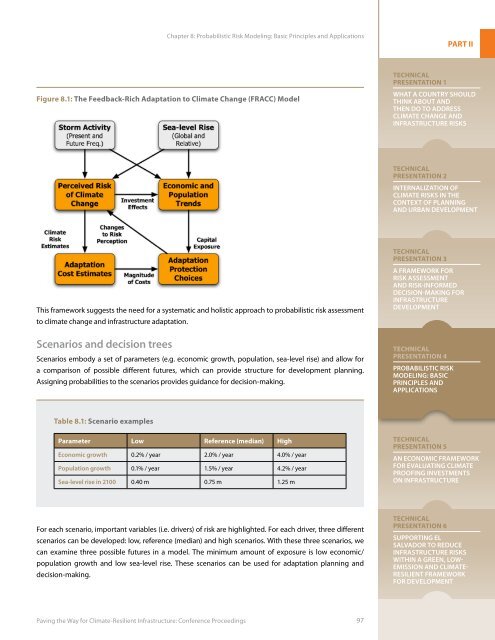Paving the Way for Climate-Resilient Infrastructure - UN CC:Learn
Paving the Way for Climate-Resilient Infrastructure - UN CC:Learn
Paving the Way for Climate-Resilient Infrastructure - UN CC:Learn
You also want an ePaper? Increase the reach of your titles
YUMPU automatically turns print PDFs into web optimized ePapers that Google loves.
Chapter 8: Probabilistic Risk Modeling: Basic Principles and ApplicationsPART IITechnicalPresentation 1Figure 8.1: The Feedback-Rich Adaptation to <strong>Climate</strong> Change (FRA<strong>CC</strong>) ModelWhat a Country ShouldThink About andThen Do to Address<strong>Climate</strong> Change and<strong>Infrastructure</strong> RisksTechnicalPresentation 2Internalization of<strong>Climate</strong> Risks in <strong>the</strong>Context of Planningand Urban DevelopmentTechnicalPresentation 3This framework suggests <strong>the</strong> need <strong>for</strong> a systematic and holistic approach to probabilistic risk assessmentto climate change and infrastructure adaptation.Scenarios and decision treesScenarios embody a set of parameters (e.g. economic growth, population, sea-level rise) and allow <strong>for</strong>a comparison of possible different futures, which can provide structure <strong>for</strong> development planning.Assigning probabilities to <strong>the</strong> scenarios provides guidance <strong>for</strong> decision-making.A Framework <strong>for</strong>Risk Assessmentand Risk-In<strong>for</strong>medDecision-Making <strong>for</strong><strong>Infrastructure</strong>DevelopmentTechnicalPresentation 4Probabilistic RiskModeling: BasicPrinciples andApplicationsTable 8.1: Scenario examplesParameter Low Reference (median) HighEconomic growth 0.2% / year 2.0% / year 4.0% / yearPopulation growth 0.1% / year 1.5% / year 4.2% / yearSea-level rise in 2100 0.40 m 0.75 m 1.25 mTechnicalPresentation 5An Economic Framework<strong>for</strong> Evaluating <strong>Climate</strong>Proofing Investmentson <strong>Infrastructure</strong>For each scenario, important variables (i.e. drivers) of risk are highlighted. For each driver, three differentscenarios can be developed: low, reference (median) and high scenarios. With <strong>the</strong>se three scenarios, wecan examine three possible futures in a model. The minimum amount of exposure is low economic/population growth and low sea-level rise. These scenarios can be used <strong>for</strong> adaptation planning anddecision-making.TechnicalPresentation 6Supporting ElSalvador to Reduce<strong>Infrastructure</strong> Riskswithin a Green, Low-Emission and <strong>Climate</strong>-<strong>Resilient</strong> Framework<strong>for</strong> Development<strong>Paving</strong> <strong>the</strong> <strong>Way</strong> <strong>for</strong> <strong>Climate</strong>-<strong>Resilient</strong> <strong>Infrastructure</strong>: Conference Proceedings 97
















